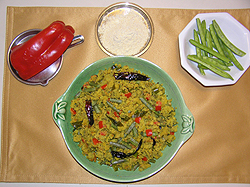|
Avakayi (Mango Pickle)

½ When someone asks you which state in India you
are from, and you say “I come from Andhra Pradesh”, the usual
response is, “Ooooh I love avakayi and gongura chutney”. Then the
conversation continues: “Have you been to Andhra? Which places did
you visit?” By the time you finish your conversation you end up
inviting him or her to your house and become great friends.
8 Very green and hard mangoes
4 Cups ground red pepper (mild if you don’t like it to be very hot)
4 Cups mustard powder. (Take whole mustard seeds and powder them in
spice grinder until you have four cups powder)
1 Teaspoon turmeric powder (haldi)
3 cups salt
1 Cup clear sesame seed oil (divided 1/2 cup+1/4 cup +1/4 cup)
¼ Cup methi seeds
½ Cup small dry chickpeas (optional)
1 Cup small peeled garlic cloves (optional)
2 Cups clear sesame seed oil (for third day)
Cut each mango in to 16 or 20 pieces (with part of the seed attached
to most pieces). In a large stainless steel bowl, mix red pepper,
mustard powder, turmeric, salt, half a cup of oil, methi seeds,
chickpeas, and garlic with clean dry hands. You may have to use
plastic (not latex) gloves if your hands are sensitive to the red
pepper powder.
Take a large dry glass bowl or plastic bowl and pour 1/4th cup of
oil. Sprinkle ½ a cup of red pepper mixture on top of the oil in the
bowl.
Take a hand full of mango pieces and put them in the stainless steel
red pepper bowl and mix until the spices coat on mango pieces and
put them in the glass bowl. Repeat this process with all the mango
pieces and pack them. Sprinkle left over spices on top of mangoes
and sprinkle 1/4th cup of the oil on top. Cover the bowl with
plastic wrap and keep a heavy plate like pizza plate on top of the
bowl.
Keep the bowl in a dry place for three days without mixing. On third
day mix the pickle with wooden spoon and pour 1 cup of oil and mix
thoroughly.
Storing: Take a large glass bottle. Pour ½ a cup of oil in the
bottom of the bottle and fill the bottle with pickle. Pour the
remaining ½ cup oil on top of the pickle. Store it in the
refrigerator to keep the color and also to keep the mango pieces
hard. Never use wet spoons to serve.
A little bit of nostalgia: Whenever I make this pickle or eat, it
takes me back to my days in our village in India. Making mango
pickles those days is a major event in the summer season lasting two
weeks. First we have to go to the mango grove and pick mangoes that
are just ready for pickling. Then we make sesame oil. To do this
they have to soak the sesame seeds with skin over night, take them
to Godavari river to wash the skin, dry them and take them to the
oil-making machine (ganuga). And then the powders have to be made
fresh one by one. We used to call it the Avakayi season.
Guvar Bean Patoli (Goruchikkudukayi
Patoli)

2 ½ Pound guvar bean pods (washed, stringed and cut in to one inch
pieces)
¾ Cups water
1 Teaspoon salt (divided ½ + ½)
2 Tablespoons oil
½ Teaspoon red mustard seeds
3 Red dry chilies
1 Teaspoon urad dal
½ Teaspoon cumin seed
1/8 Teaspoon asafoetida (hing)
¼ Teaspoon turmeric (haldi)
2 Green chilies chopped
2 Stems curry leaves
½ Red bell pepper (cut into half inch slices)
1 Cup laddu besan (coarse chick pea flour)
Boil ¾ cup water in a medium size non-stick skillet. Add half a
teaspoon salt and the bean pods and cook for three minutes. Drain
the beans saving ¼ cup water. Keep the beans aside.
Return the pan to the stove. Heat two tablespoons oil and add
mustard seeds. When the mustard seeds start to pop, add red chilies,
urad dal and cumin seeds. Fry until urad dal is light brown and add
rest of the ingredients (asafoetida, turmeric, green chilies, curry
leaves, red bell pepper slices and laddu basen) Fry in low heat for
two minutes being careful not to let the basen burn. Add beans, ¼
cup water and remaining half a teaspoon salt. Mix well and cover for
a minute and stir gently so that the beans retain the shape. If it
is not hot enough mix little ground red pepper. Tastes good with
rice.
Note: Instead of laddu besan, you can use chana dal (soaked for two
or three hours and blended). But this will consume more time and
more oil for frying.
Archives:
Make Indian Sweets Healthier without Sacrificing the Taste Simple
Dessert Recipes
Hot
Drinks
Coconut
Shrimp & Saffron Rice
Golden
Turmeric
Quick & Delicious Dishes in 30 Minutes or Less
|



